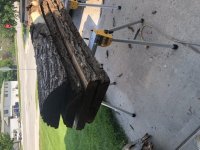Just got through a 2 year drying process myself. I used concrete blocks to build a foundation and laid 4x4s across to hold the wood off the ground on a level slab, stickered with the same species of wood, covered the top with a piece of plywood with plastic stapled to it, and used ratchet straps to create the even downward pressure on the stack to keep it from warping. They will need to be occasionally tightened.
Lessons learned: I also sealed the ends too late. Waited a couple of days after it was cut down to seal the ends, but did it immediately after bandsawing and then trimming the ends a bit. I still got some end checking and some cracks all the way through the middle, which resulted in many of the slabs needing to turn into boards by cutting out the very center of the tree. Surface checking was also apparent, which I've been told you can limit by keeping it wet with a sprinkler if it was cut in the summer. Better time to mill and start drying is in the dryer winter/early spring months so that the surface moisture doesn't leave too rapidly.
You're in for a long road ahead, but the results, even if not what were expected, are still fantastic, and you'll learn a lot if you decide to do it again.


